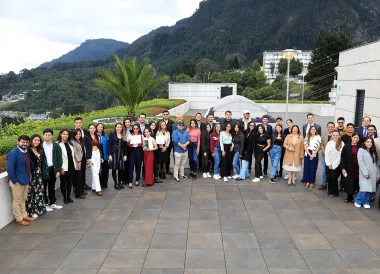29 de septiembre de 2023
LEGAL PROTECTION FOR INNOVATION STRATEGIES
INTRODUCTION
Innovation is crucial for the long-term success and competitiveness of companies in the rapidly evolving business landscape. To foster innovation, companies employ various strategies and approaches. To protect your innovation, you can utilize various forms of intellectual property (IP) rights. The choice of which IP protection to pursue depends on the nature of your innovation and your business goals.
Before pursuing any form of IP protection, the following steps are recommended:
- Conduct a Prior Art Search: To ensure your innovation is truly novel and eligible for protection, conduct a thorough search to identify prior art (previous similar inventions or creations) that might impact your ability to obtain protection.
- Consult Legal Experts: Intellectual property laws can be complex and vary by jurisdiction. Consult with intellectual property attorneys who specialize in the relevant field to guide you through the process and help you make informed decisions.
- Strategize: Develop an IP strategy aligned with your business goals. Some innovations may benefit from a combination of protections, while others may require choosing the most suitable single form of protection.
Obtaining IP protection is just one step; enforcing and maintaining these rights require ongoing attention and legal vigilance.
COMMON INNOVATION STRATEGIES THAT COMPANIES OFTEN USE:
- Open Innovation: This approach involves collaborating with external partners such as customers, suppliers, universities, and even competitors to bring in fresh ideas, technologies, and expertise. Companies share and exchange knowledge to accelerate the innovation process.
- Research and Development (R&D): Companies allocate resources to research and develop new products, services, or technologies. This can involve creating dedicated R&D departments or innovation labs to focus solely on generating novel ideas and solutions.
- Design Thinking: Design thinking is a human-centered approach that emphasizes empathy, collaboration, and iteration. Companies using this strategy involve cross-functional teams to deeply understand user needs, brainstorm solutions, prototype, and test ideas before implementation.
- Disruptive Innovation: This strategy involves introducing new products or services that create a significant shift in the market and often target underserved or overlooked customer segments. Disruptive innovations can reshape industries and change consumer behaviors.
- Incremental Innovation: Companies continuously improve existing products, services, or processes to enhance efficiency, performance, and user experience. This strategy involves making small, incremental changes over time.
- Blue Ocean Strategy: This approach focuses on creating entirely new market spaces where competition is limited or nonexistent. Companies aim to offer unique value propositions, differentiating themselves from competitors and attracting new customers.
- Acquisitions and Mergers: Some companies acquire or merge with other firms to gain access to their technologies, products, or intellectual property, thereby accelerating their own innovation efforts.
- Lean Startup Methodology: Popularized by Eric Ries, this strategy involves quickly building and testing minimal viable products (MVPs) to gather user feedback and iterate rapidly based on that feedback. This approach minimizes waste and reduces the risk of launching products that don’t meet customer needs.
- Crowdsourcing: Companies solicit ideas and solutions from a large group of people, often through online platforms, competitions, or challenges. This approach leverages the collective intelligence of a diverse group to solve problems and generate new ideas.
- Corporate Venture Capital: Companies invest in startups or innovative ventures that align with their strategic goals. This approach provides the company with insights into emerging trends and technologies while supporting external innovation.
- Technology Scouting: Companies actively search for emerging technologies, ideas, and trends outside their industry and then adapt or integrate them into their own operations or products.
- Intrapreneurship: This strategy involves encouraging employees to act as entrepreneurs within the company, empowering them to propose and develop new ideas and projects.
- Hackathons and Innovation Challenges: These events encourage employees or external participants to collaborate intensively over a short period to solve specific problems or develop innovative solutions.
- Agile Development: Agile methodologies, often used in software development, emphasize iterative development and collaboration, allowing companies to respond quickly to changing market demands.
- Successful innovation strategies are often tailored to a company’s industry, culture, and specific goals. The key is to create a conducive environment that encourages creativity, experimentation, and a willingness to embrace change.
KEY POINTS OF AN INNOVATION STRATEGY IN A COMPANY:
An effective innovation strategy in a company should encompass various key points to guide and support the organization’s efforts in creating and implementing innovative ideas. Here are some essential points to consider when developing an innovation strategy:
- Clear Objectives: Define specific innovation goals that align with the company’s overall mission and business strategy. These objectives should be measurable and time-bound, providing a clear sense of direction for the innovation initiatives.
- Alignment with Business Strategy: Ensure that the innovation strategy is closely aligned with the company’s core business strategy. Innovation efforts should contribute to the company’s competitive advantage and long-term growth.
- Leadership Support: Obtain commitment and active support from top leadership. Leaders should champion the importance of innovation and allocate necessary resources to foster a culture of creativity.
- Resource Allocation: Allocate dedicated resources, including funding, time, and personnel, to support innovation projects. Adequate resources are essential for experimentation and development of new ideas.
- Cross-Functional Collaboration: Encourage collaboration between different departments and teams. Innovative ideas often emerge at the intersection of different disciplines, so fostering a culture of collaboration can lead to breakthroughs.
- Open Communication: Establish channels for open communication that allow employees to share their ideas, feedback, and suggestions. Creating an environment where employees feel valued and heard fosters innovation.
- Risk Tolerance: Cultivate a culture that embraces calculated risk-taking. Innovation involves experimentation, and not all ideas will succeed. It’s important to learn from failures and iterate on ideas.
- Customer-Centric Approach: Focus on understanding customer needs and pain points. Innovations that directly address customer challenges are more likely to gain traction in the market.
- Continuous Learning: Encourage continuous learning and professional development. Provide opportunities for employees to acquire new skills and stay updated on industry trends and emerging technologies.
- Idea Generation and Management: Implement processes for generating, capturing, evaluating, and selecting innovative ideas. This might involve brainstorming sessions, idea submission platforms, and cross-functional evaluation teams.
- Innovation Metrics: Define key performance indicators (KPIs) to measure the effectiveness of innovation efforts. These metrics could include the number of new products launched, revenue from new products, or percentage of revenue from products developed in the last few years.
- Innovation Culture: Nurture a culture that values creativity, curiosity, and continuous improvement. Recognize and reward employees for their innovative contributions.
- Innovation Pathways: Develop a framework for moving innovative ideas from concept to implementation. This could include stages for idea validation, prototyping, testing, and scaling.
- External Partnerships: Explore opportunities for collaboration with external partners, such as startups, research institutions, and industry experts. These partnerships can bring fresh perspectives and accelerate innovation.
- Intellectual Property Protection: Establish procedures for protecting intellectual property generated through innovation. This could involve patent applications, copyrights, and trade secrets.
- Adaptability: Recognize that the innovation landscape is constantly evolving. Be prepared to adapt the strategy as new opportunities and challenges arise.
- Measurement and Feedback Loop: Regularly review and assess the progress of innovation projects against established objectives. Use feedback to refine and improve the strategy over time.
An innovation strategy should be tailored to your company’s unique circumstances, goals, and industry context. It’s important to create a strategy that resonates with your organization’s culture and capabilities.
KEY ELEMENTS OF A LEGAL PROTECTION FOR AN INNOVATION STRATEGY:
Protecting your innovation strategy involves a combination of legal measures to safeguard your intellectual property, proprietary information, and competitive advantage. The advisable steps to ensure comprehensive legal protection for an innovation strategy are the following:
- Intellectual Property (IP) Strategy:
- Patents: If your innovation involves a novel, non-obvious, and useful invention, consider filing for patents. Patents grant exclusive rights to your invention for a specific period, preventing others from making, using, selling, or importing it without your permission.
- Copyrights: If your innovation includes original creative works such as software code, artistic designs, or written content, consider obtaining copyrights to protect against unauthorized copying or distribution.
- Trademarks: Register trademarks for unique brand names, logos, and symbols associated with your innovation strategy. Trademarks protect your brand identity and prevent others from using similar marks that might cause confusion.
- Trade Secrets: Implement strict confidentiality measures to protect sensitive information that provides your company with a competitive advantage. This could include proprietary processes, customer lists, formulas, and more.
- Non-Disclosure Agreements (NDAs): When sharing confidential information with employees, partners, contractors, or potential collaborators, use NDAs to legally bind them to maintain confidentiality and prevent unauthorized disclosure.
- Employee and Contractor Agreements: Include clauses in employment and contractor agreements that specify that any innovations or intellectual property developed during their tenure belong to the company. This helps ensure the company’s ownership of innovations created by its workforce.
- Partnership and Collaboration Agreements: Clearly outline intellectual property ownership, usage rights, and profit-sharing arrangements in agreements when collaborating with external partners, vendors, or research institutions.
- Licensing Agreements: If you’re interested in monetizing your innovation by allowing others to use it, consider licensing agreements that define the terms under which others can use your intellectual property.
- Innovation Disclosure Policies: Develop internal policies and procedures for employees to disclose their innovative ideas and developments. This establishes a framework for capturing and evaluating new concepts.
- Regular IP Audits: Periodically assess your intellectual property portfolio to ensure that your patents, copyrights, trademarks, and trade secrets are up to date and aligned with your innovation strategy.
- Global Considerations: If your innovation strategy has an international component, be aware of intellectual property laws and regulations in various jurisdictions. File for protection in countries where you plan to operate or expand.
- Litigation Preparedness: While prevention is the primary goal, it’s wise to have a plan in place in case of IP infringement. Consult legal experts to understand your options for enforcing your rights and pursuing legal action if necessary.
- Legal Counsel: Consult with intellectual property attorneys who specialize in the relevant areas, such as patent law, copyright law, and trademark law. They can provide tailored guidance based on your specific innovation strategy.
MAIN CONTRACTUAL CLAUSES TO PROTECT INNOVATION MODELS AND PRODUCTS:
Some examples of clauses to be considered in contracts to protect innovation and intellectual property (IP):
- Confidentiality and Non-Disclosure Clause:
“Confidential Information” refers to all information disclosed by one party to the other that is not publicly available and is marked or communicated as confidential. The recipient agrees not to disclose or use the Confidential Information for any purpose other than the intended collaboration/project and to protect its confidentiality.
- Intellectual Property Ownership Clause:
“Any inventions, designs, works of authorship, developments, concepts, ideas, or other intellectual property created during the term of this Agreement shall be the exclusive property of [Company Name], regardless of which party contributed to their creation.”
- Assignment of Intellectual Property Rights Clause:
“Employee/Contractor hereby assigns and transfers to [Company Name] all rights, title, and interest in and to any and all intellectual property created in the course of employment/engagement, and agrees to execute any necessary documentation to effectuate such assignment.”
- Joint Ownership Clause (for collaborations):
“Any jointly developed intellectual property shall be owned jointly by the parties in proportion to their respective contributions. The parties agree to work together to secure appropriate protection and make commercialization decisions.”
- Non-Compete and Non-Solicitation Clause:
“During the term of this Agreement and for [X] years thereafter, the Employee/Contractor agrees not to engage in any business that competes with [Company Name] or solicit [Company Name]’s clients, customers, or employees.”
- Dispute Resolution Clause:
“Any dispute arising under or in connection with this Agreement, including disputes related to intellectual property rights, shall be resolved through mediation or arbitration, with [Arbitration/Mediation Provider] acting as the mediator/arbitrator.”
- Indemnification Clause:
“Employee/Contractor agrees to indemnify and hold harmless [Company Name] from any claims, damages, or liabilities arising from any breach of intellectual property rights or misuse of confidential information.”
- Termination and Return of Property Clause:
“Upon termination of this Agreement, Employee/Contractor shall promptly return to [Company Name] all confidential information, documents, and materials related to the project, including any prototypes, designs, and research.”
- Use of Company Resources Clause:
“Employee/Contractor shall not use [Company Name]’s resources, facilities, or equipment for any purposes other than the project specified in this Agreement, without prior written consent.”
- Governing Law and Jurisdiction Clause:
“This Agreement shall be governed by and construed in accordance with the laws of [Jurisdiction]. Any disputes arising under or in connection with this Agreement shall be subject to the exclusive jurisdiction of the courts of [Jurisdiction].”
CONCLUDING REMARKS:
Failing to seek IP protection in a timely manner can result in the loss of rights. It’s important to initiate the protection process as soon as your innovation is ready to be disclosed to others.
Not keeping thorough and organized records of the development process, dates of invention, and interactions with collaborators or partners can weaken your ability to prove the originality and ownership of your innovation. Neglecting to conduct a thorough search for existing patents, copyrights, trademarks, and other IP rights similar to your innovation can lead to conflicts, rejections, or invalidations of your claims.
Drafting incomplete or vague agreements, such as nondisclosure agreements (NDAs) or partnership contracts, can leave gaps in IP ownership and usage rights, leading to disputes later on. Not properly safeguarding trade secrets through contractual agreements and security measures can result in leaks of sensitive information, compromising your competitive advantage.
Disclosing details about your innovation to the public before applying for IP protection can impact your ability to obtain patents or certain types of protection. Public disclosures can trigger statutory grace periods in some jurisdictions. Failing to include strong IP ownership and assignment clauses in employee agreements can lead to uncertainties about who owns the rights to innovations created by employees.
If you plan to operate globally, not considering international IP protection can leave your innovation vulnerable in jurisdictions where you haven’t secured rights.
Licensing your IP without clear terms, usage limitations, and enforcement mechanisms can lead to unauthorized use or disputes. Confusing the differences between patents, copyrights, trademarks, and trade secrets can result in pursuing the wrong type of protection for your innovation.
Assuming that you don’t need to take any legal steps to protect your innovation can leave you exposed to IP theft or infringement. Forgetting to renew trademarks, pay maintenance fees for patents, or keep documentation up to date can lead to the loss of your IP rights.
Not actively monitoring for IP infringement and taking appropriate legal action when needed can weaken your IP position and allow others to infringe on your innovation. Relying on inexperienced or uninformed legal advisors can result in inadequate protection or misguided strategies.
Artículos Recientes
¡Ya está disponible el caso! Segunda versión del Concurso Laboratorio de Estrategia Legal #LSL
Invitamos a los estudiantes de pregrado y postgrado de todas las carreras a presentar [...]
Masterclass Legal Operations: Transformando la Función Legal Empresarial de Guardián de Riesgos a Creador de Valor.
El Departamento de Derecho de los Negocios y la Facultad de Administración de Empresas [...]
Conclusión del Proceso de Reforma al Investor-State Dispute Settlement
En la semana del 12 de julio de 2023, durante la sesión anual de [...]
El Departamento de Derecho de los Negocios de la Universidad Externado de Colombia abre convocatoria para la vacante de Asistente de Investigación
¡Sé parte de nuestro equipo de trabajo! Perfil del cargo: Asistente de Investigación Apoyar [...]
Docente del Departamento de Derecho de los Negocios participó en el libro Blanco de la Asociación de Derecho Internacional
La Asociación de Derecho Internacional (ADI), una de la organizaciones más antiguas y prestigiosas [...]
CRYPTO IN COLOMBIA: PROSPECTIVE 2022
By: Daniel Peña Valenzuela The volatility of the main cryptocurrencies seems to be once [...]
Convocatoria de Monitores.
El Departamento de Derecho de los Negocios se complace en anunciar la apertura para [...]
¿Se avecina una regulación de la Franquicia por parte del Gobierno? ¿O lo impedirá la Corte Constitucional?
Por: Juan Miguel Álvarez* y Diana Marcela Araujo* En diciembre del 2020, el congreso [...]
Ciclo de seminarios de Innovaciones en Justicia Digital: un espacio desde la academia que replantea el futuro del sistema de justicia.
El Seminario en Innovaciones en Justicia Digital es un evento de la Universidad Externado [...]
Rostros de mentira: Retos legales producidos por las ‘Deepfakes’
Palabras clave: Deepfake, IA, contenidos audiovisuales, redes generativas adversarias, derecho probatorio, intimidad personal. Una [...]
Memorias: Tercer seminario de innovaciones en la justicia digital- aplicaciones de la inteligencia artificial en la práctica judicial.
El pasado 19 de septiembre de 2024, las instalaciones de la Universidad Externado fueron [...]
Celebramos la realización del 40º Congreso Nacional de Derecho Comercial: Novedades y retos de la contratación mercantil y del arbitraje comercial
El pasado 30 de octubre, en Medellín, se celebró el 40º Congreso Nacional de [...]


















